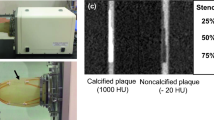Abstract
Our aim was to investigate when halfcycle reconstruction (HCR) was feasible in patients who were predicted to have a heart rate over 65 bpm in coronary CT angiography (CTA) using 320-row CT. Seventy-four patients who underwent multiple heart beat scanning were included. The time to reach 230 HU at the ascending aorta during the bolus tracking scan was recorded (T230). HCR image and multicycle reconstruction (MCR) image were reconstructed for each patient. Image quality for each coronary segment was rated on a 3-point scale (3: good, 1: poor). For each patient, we determined that a single beat acquisition was feasible for diagnosis (HCR group) when the number of segments graded score 1 in the HCR image was the same or less than that in the MCR image. Otherwise, we included the patients in the MCR group. HCR group and MCR group included 38 and 36 patients, respectively. Regression analysis showed that body height >1.66 m (odds ratio (OR), 5.74; CI 1.59–25.6; p < 0.007), T230 >16 s (OR 3.11; CI 1.07–9.58; p = 0.04), and heart rate ≤72 bpm (OR 3.18; CI 1.11–9.49; p = 0.03) were related with the HCR group. When all three criteria were fulfilled, the calculated probability that MCR would improve image quality was only 7 %. When the heart rate is ≤72 bpm, single heart beat acquisition is feasible for patients with body height >1.66 m and T230 > 16 s in coronary CTA using 320-row CT.


Similar content being viewed by others
References
West AM, Beller GA (2010) 256- and 320-row coronary CTA: is more better? Eur Heart J 31:1823–1825
Muenzel D, Noel PB, Dorn F et al (2011) Step and shoot coronary CT angiography using 256-slice CT: effect of heart rate and heart rate variability on image quality. Eur Radiol 21:2277–2284
de Graaf FR, Schuijf JD, van Velzen JE et al (2010) Diagnostic accuracy of 320-row multidetector computed tomography coronary angiography in the non-invasive evaluation of significant coronary artery disease. Eur Heart J 31:1908–1915
Wicky S, Rosol M, Hoffmann U et al (2003) Comparative study with a moving heart phantom of the impact of temporal resolution on image quality with two multidetector electrocardiography-gated computed tomography units. J Comput Assist Tomogr 27:392–398
Dewey M, Laule M, Krug L et al (2004) Multisegment and halfscan reconstruction of 16-slice computed tomography for detection of coronary artery stenoses. Invest Radiol 39:223–229
Lee AB, Nandurkar D, Schneider-Kolsky ME et al (2011) Coronary image quality of 320-MDCT in patients with heart rates above 65 beats per minute: preliminary experience. Am J Roentgenol 196:729–735
Khan A, Khosa F, Nasir K et al (2011) Comparison of radiation dose and image Quality: 320-MDCT versus 64-MDCT coronary angiography. Am J Roentgenol 197:163–168
Herzog C, Nguyen SA, Savino G et al (2007) Does two-segment image reconstruction at 64-section CT coronary angiography improve image quality and diagnostic accuracy? Radiology 244:121–129
Matt D, Scheffel H, Leschka S et al (2007) Dual-source CT coronary angiography: image quality, mean heart rate, and heart rate variability. Am J Roentgenol 189:567–573
Tomizawa N, Komatsu S, Akahane M et al (2012) Relationship between beat to beat coronary artery motion and image quality in prospectively ECG-gated two heart beat 320-detector row coronary CT angiography. Int J Cardiovasc Imaging 28:139–146
Mosteller RD (1987) Simplified calculation of bodysurface area. N Engl J Med 317:1098
Hausleiter J, Meyer T, Hermann F et al (2009) Estimated radiation dose associated with cardiac CT angiography. JAMA 301:500–507
Austen WG, Edwards JE, Frye RL et al (1975) A reporting system on patients evaluated for coronary artery disease. Report of the Ad Hoc Committee for Grading of Coronary Artery Disease, Council on Cardiovascular Surgery, American Heart Association. Circulation 51:5–40
Cohen J (1960) A coefficient of agreement for nominal scales. Educ Psychol Meas 20:37–46
Bae KT (2010) Intravenous contrast medium administration and scan timing at CT: considerations and approaches. Radiology 256:32–61
Jensen CJ, Jochims M, Hunold P et al (2010) Assessment of left ventricular function and mass in dual-source computed tomography coronary angiography: influence of beta-blockers on left ventricular function: comparison to magnetic resonance imaging. Eur J Radiol 74:484–491
Leschka S, Stolzmann P, Desbiolles L et al (2009) Diagnostic accuracy of high-pitch dual-source CT for the assessment of coronary stenoses: first experience. Eur Radiol 19:2896–2903
Conflict of interest
One author (R.T.) is an employee of Toshiba Medical Systems.
Author information
Authors and Affiliations
Corresponding author
Rights and permissions
About this article
Cite this article
Tomizawa, N., Yamamoto, K., Akahane, M. et al. The feasibility of halfcycle reconstruction in high heart rates in coronary CT angiography using 320-row CT. Int J Cardiovasc Imaging 29, 907–911 (2013). https://doi.org/10.1007/s10554-012-0151-0
Received:
Accepted:
Published:
Issue Date:
DOI: https://doi.org/10.1007/s10554-012-0151-0




